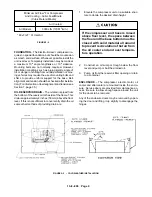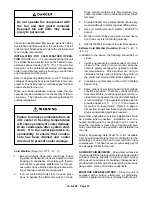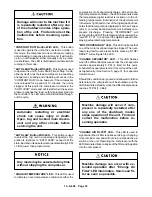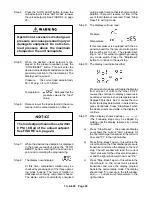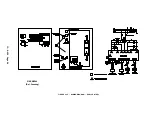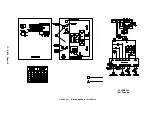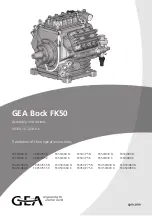
13–8–609 Page 10
Do not operate the compressor with
the fan and belt guard removed.
Exposed fan and belts may cause
injury to personnel.
The motor inspection/air filter service panel is held by
two latches and lifts away from the enclosure. The air
outlet panel is attached by screws to the enclosure and
is not readily removeable.
INSTALLATION FOR COLD WEATHER OPERA-
TION (FIGURE 2–3) – It is recommended that the unit
be installed inside a shelter that will be heated to tem-
peratures above freezing (32
o
F, 0
o
C). This will elimi-
nate many of the problems associated with operating
units in cold climates, such as freezing in control lines
and downstream of the cooler.
Refer to Engineering Data Sheet 13–9–411 for the ad-
vantages of using the heat recovered from rotary com-
pressors. This heat recovery could easily pay for an ad-
equate shelter for the unit.
When an outside installation must be made, the pre-
cautions required will depend on the severity of the en-
vironment. The following are general guidelines for
outside installations:
Failure to remove condensate from an
idle cooler in freezing temperatures
will cause permanent cooler damage.
Drain condensate after system shut-
down. It is the owner/operator’s re-
sponsibility to ensure that conden-
sate has been drained and cooler
dried out to prevent cooler damage.
Cold Weather (Down To +10
o
F, –12
_
C)
1.
Be sure all drains, traps, and control lines, includ-
ing pressure transducer lines are heated to avoid
freezing of condensate. Heat tape with thermo-
stat control is generally satisfactory for this pur-
pose and can be obtained at various local plumb-
ing or hardware outlets at nominal cost.
2.
If an air–cooled aftercooler is to be used, provi-
sions to bypass the aftercooler must be made.
Since cold air contains very little moisture, suc-
cessful operation can be achieved without the af-
tercooler.
3.
Provide at least some simple shelter such as a ply-
wood windbreak to protect against drifting snow.
4.
Use only Gardner Denver
R
AEON
t
9000 SP lu-
bricant.
5.
Monitor unit carefully during start–up and opera-
tion to be sure it is functioning normally.
6.
Specify NEMA 4 enclosure for electrical devices.
Extreme Cold Weather Operation (Down To –40
_
F,
–40
_
C)
In addition to the above, the following should be pro-
vided:
1.
It will be necessary to provide shutters or to block
off part of the cooler in some manner since the
cooler is greatly oversized for operation in these
low temperatures. Since shutters are not pro-
vided as a factory option, blocking off a portion of
the cooler with plywood should be satisfactory.
2.
In extreme environments, run the unit in “Constant
Speed” only.
3.
Some means of providing heat during shutdown
should be provided. There are various methods
to accomplish this, but since openings are not pro-
vided for sump heaters, the use of radiant heaters
is recommended. The heaters should be sized to
provide at least a +10
_
F (–12
_
C) environment
for coolers, motor and sump. Figure 2–3, page 9,
this section, shows how these might be located in
a typical installation and sizes required.
Remember unsheltered (outside) installations should
be avoided where possible. Installation next to a
heated building where enough heat can be used to
keep the compressor room above freezing will save
many complications in the operation and installation of
the unit.
Refer to Engineering Data Sheet 13–9–411, available
from an authorized Gardner Denver distributor, for the
advantages of using the heat recovered from rotary
compressors. This heat recovery could easily pay for
an adequate shelter for the unit.
AUXILIARY AIR RECEIVER – An auxiliary air receiver
is not required if the piping system is large and provides
sufficient storage capacity to prevent rapid cycling.
When used, an air receiver should be of adequate size,
provided with a relief valve of proper setting, a pressure
gauge and a means of draining condensate.
MOISTURE SEPARATOR/TRAP – Since the unit is
equipped with a built–in aftercooler, a combination
moisture separator and trap is furnished with the unit.
Summary of Contents for ELECTRA-SCREW EBE DH-15 HP
Page 14: ...13 8 609 Page 6 DECALS 206EAQ077 212EAQ077 218EAQ077 211EAQ077 207EAQ077...
Page 15: ...13 8 609 Page 7 DECALS 216EAQ077 217EAQ077 222EAQ077 221EAQ077 208EAQ077...
Page 32: ...13 8 609 Page 24 FIGURE 4 10 WIRING DIAGRAM DUAL CONTROL 218EBE546 Ref Drawing...
Page 33: ...13 8 609 Page 25 FIGURE 4 11 WIRING DIAGRAM WYE DELTA 220EBE546 Ref Drawing...
Page 51: ......














